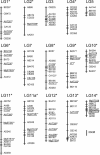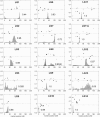Transmission ratio distortion in intraspecific hybrids of Mimulus guttatus: implications for genomic divergence
- PMID: 15781698
- PMCID: PMC1449724
- DOI: 10.1534/genetics.104.038653
Transmission ratio distortion in intraspecific hybrids of Mimulus guttatus: implications for genomic divergence
Abstract
We constructed a genetic linkage map between two divergent populations of Mimulus guttatus. We genotyped an F(2) mapping population (N = 539) at 154 AFLP, microsatellite, and gene-based markers. A framework map was constructed consisting of 112 marker loci on 14 linkage groups with a total map length of 1518 cM Kosambi. Nearly half of all markers (48%) exhibited significant transmission ratio distortion (alpha = 0.05). By using a Bayesian multipoint mapping method and visual inspection of significantly distorted markers, we detected 12 transmission ratio distorting loci (TRDL) throughout the genome. The high degree of segregation distortion detected in this intraspecific map indicates substantial genomic divergence that perhaps suggests genomic incompatibilities between these two populations. We compare the pattern of transmission ratio distortion in this map to an interspecific map constructed between M. guttatus and M. nasutus. A similar level of segregation distortion is detected in both maps. Collinear regions between maps are compared to determine if there are shared genetic patterns of non-Mendelian segregation distortion within and among Mimulus species.
Figures



References
-
- Diaz, A., and M. R. MacNair, 1999. Pollen tube competition as a mechanism of prezygotic isolation between Mimulus nasutus and its presumed progenitor M. guttatus. New Phytol. 144: 471–478. - PubMed
Publication types
MeSH terms
Substances
LinkOut - more resources
Full Text Sources
Miscellaneous

